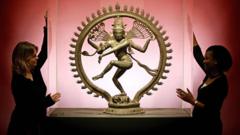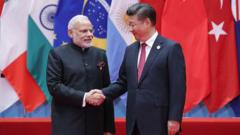From the monumental Brihadishvara temple to vibrant trade networks with far-off lands, the Chola dynasty exemplified cultural and economic prowess that influenced centuries of development.
Temples, Trade, and Triumph: Unveiling the Chola Dynasty's Global Impact

Temples, Trade, and Triumph: Unveiling the Chola Dynasty's Global Impact
Delve into the extraordinary legacy of the Chola dynasty, whose innovations and conquests transformed South India and reshaped global trade during the medieval period.
The Chola dynasty, often overshadowed in historical narratives, was a cornerstone in shaping medieval society both in India and beyond. At the forefront of this remarkable dynasty was Raja-Raja Chola, who, in the 11th century, commissioned the monumental Brihadishvara temple, a UNESCO World Heritage site measuring an impressive 216 feet and constructed from 130,000 tonnes of granite. This architectural marvel served not only as a religious edifice but also a testament to the Chola economy, which was bolstered by resources appropriated from the conquered territories, including Lanka, where the Cholas established a permanent footprint.
Unlike their contemporaries in Europe, the Cholas recognized the importance of branding and public relations, particularly through the prominent role of their queens. Sembiyan Mahadevi, a matriarch of the dynasty, revitalized the family’s image and devotion to Shiva through her ambitious projects that mirrored the artistic and spiritual grandeur of their temples, including the adoration for the lesser-known deity Nataraja, now a significant figure in Hinduism.
Raja-Raja's military endeavors, such as his operations against the Western Ghats and the establishment of a Chola outpost in Lanka, were pivotal in amassing wealth that funded extensive public works, including the temple which received massive quantities of agricultural produce. This feat of logistical management enabled the creation of irrigation systems and expansive farming efforts, enhancing agricultural productivity across the region.
The Cholas' maritime ventures marked them as key players in the Indian Ocean economy. Their successor, Rajendra Chola, engaged in significant naval expeditions, including the raid on Kedah, underscoring the interconnected maritime trade network that allowed Tamil merchants to flourish. Unlike traditional military colonization, Chola influence was characterized by a diaspora of Tamil traders who expanded into Southeast Asia, where they established economic dominance, striking a balance of power with local leaders.
By the late medieval period, Tamil merchants had forged a trans-oceanic commerce network that extended their reach even further, influencing trade dynamics as far as China. The multiethnic and multicentric nature of Chola cities established a melting pot of cultures, fostering interactions that enriched the social tapestry of South India.
Artistic endeavors under the Chola dynasty produced exquisite metalwork, aligning with and even rivaling renowned European artists. The richness of Tamil literature during this period revealed a culture steeped in magical realism, mythos, and history that set a precedent of cultural richness known long before similar movements emerged in Europe.
Through their monumental temples, vibrant trade, cultural amalgamation, and masterful artistry, the Chola dynasty remains a testament to the significance of historical narratives that have shaped our global heritage. The relics of this era, like the famous Nataraja bronzes in Western museums, remind us of an extraordinary civilization that ushered in a period of connectedness and innovation centuries ahead of its time.





















